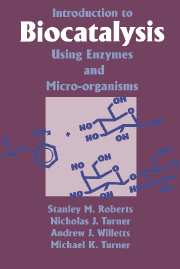Book contents
- Frontmatter
- Contents
- Preface
- Abbreviations
- 1 An historical introduction to biocatalysis using enzymes and micro-organisms
- 2 The interrelationships between enzymes and cells, with particular reference to whole-cell biotransformations using bacteria and fungi
- 3 Useful intermediates and end-products obtained from whole-cell/enzyme-catalysed hydrolysis and esterification reactions
- 4 Useful intermediates and end-products obtained from biocatalysed oxidation and reduction reactions
- 5 Useful intermediates and end-products obtained from biocatalysed carbon–carbon, carbon–oxygen, carbonnitrogen and carbon–chalcogen bond-forming reactions
- 6 The application of biocatalysis to the manufacture of fine chemicals
- Index
Preface
Published online by Cambridge University Press: 04 August 2010
- Frontmatter
- Contents
- Preface
- Abbreviations
- 1 An historical introduction to biocatalysis using enzymes and micro-organisms
- 2 The interrelationships between enzymes and cells, with particular reference to whole-cell biotransformations using bacteria and fungi
- 3 Useful intermediates and end-products obtained from whole-cell/enzyme-catalysed hydrolysis and esterification reactions
- 4 Useful intermediates and end-products obtained from biocatalysed oxidation and reduction reactions
- 5 Useful intermediates and end-products obtained from biocatalysed carbon–carbon, carbon–oxygen, carbonnitrogen and carbon–chalcogen bond-forming reactions
- 6 The application of biocatalysis to the manufacture of fine chemicals
- Index
Summary
Twenty years ago, only a handful of laboratories, some in industry and some in academia, were interested in using enzyme-catalysed reactions (biotransformations) in organic synthesis. At best those researchers were considered to be at the margin of mainstream synthetic organic chemistry; at worst they were considered to be downright odd.
In the 1980s there was an exponential increase in interest in the area of biotransformations. That worldwide increase in attention to this field of research can be assigned to several factors, including the perception and perseverance of the original researchers in the field, the increased availability of a wide variety of enzymes, and the realization that many families of enzymes will transform a wide range of unnatural compounds, as well as their natural substrates.
The utilization of enzymes in organic synthesis can be advantageous for several reasons:
Enzymes catalyse reactions under mild conditions with regard to temperature (ca. 37 °C), pressure (1 atm), and pH (ca. 7.0). The transformations are often remarkably energy-efficient when compared with the corresponding chemical processes.
Enzymes often promote highly chemoselective, regioselective, and stereoselective reactions, and being chiral catalysts, they are often able to generate optically active compounds. The increased awareness regarding the need to have optically pure compounds for such uses as Pharmaceuticals and agrichemicals (so as to avoid unnecessary toxicity and/or ecological damage) has been a significant driving force in the development and exploitation of non-natural enzyme-catalysed reactions.
[…]
- Type
- Chapter
- Information
- Publisher: Cambridge University PressPrint publication year: 1995



